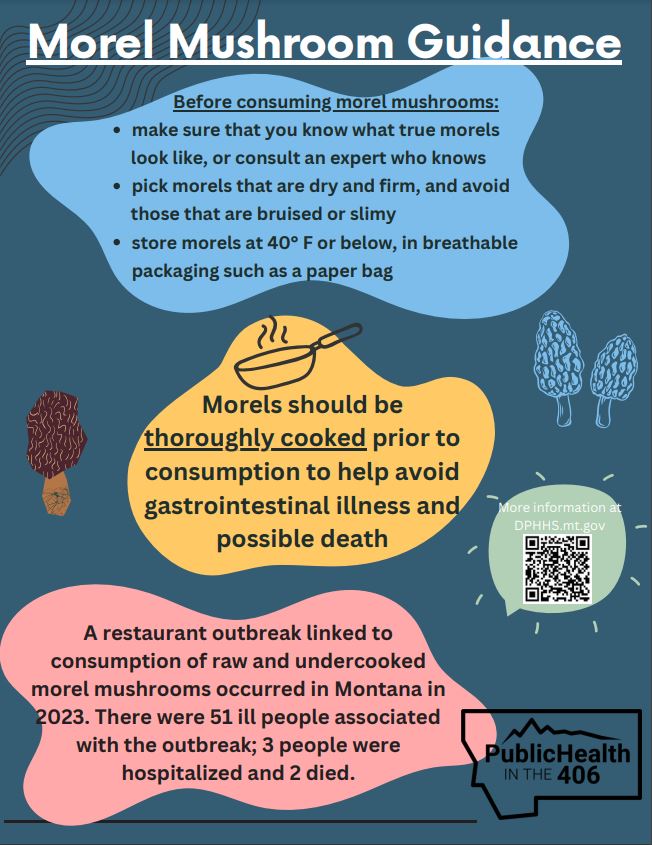Spring is a popular time for morel mushrooms in Montana. You may find them at your local farmer’s market, favorite restaurant, or while foraging for them outdoors as the weather starts to warm and the snow begins melting. There are many different species of morels, but true morels are part of the Morchella genus of mushroom, and are identifiable by their hole-like pits on the caps, or heads; additionally, true morels are hollow inside. The cap and stem of a true morel mushroom are joined at the base of the stem to make one complete unit. Morels are often considered a delicacy, but they can cause human illness if the proper identification, storage, and preparation steps are not taken.
Illness linked to consumption of morel mushrooms
In the spring of 2023, a foodborne outbreak occurred in Montana after a Bozeman restaurant served raw and undercooked morels. A total of 51 people with gastrointestinal (GI) symptoms were reported as part of this outbreak, including three hospitalizations and two deaths. Individuals became ill quickly after consumption, typically within one hour after the restaurant meal. An investigation into this outbreak found that consumption of morels at the restaurant was strongly associated with GI illness. Consumption of raw morels was more strongly associated with illness than was consumption of partially cooked morels, although even partially cooked morels were associated with illness.

The mushrooms served as part of this outbreak were confirmed through testing to be Morchella sextelata, a species of true morel. Despite additional laboratory testing, the presence of a specific toxin was not confirmed in the morel sample. The toxins in morel mushrooms are not well characterized, and further research needs to be done to better understand morel toxicity.
Outbreaks and illness linked to consumption of morels seem to occur infrequently, but may occur more often than public health professionals or medical providers currently realize because symptoms may not be severe enough to cause individuals to seek care or the illness may not be known to be associated with morel consumption. The 2023 Montana outbreak is not the first GI outbreak linked to the consumption of morels, either prepared raw or cooked to varying degrees.
More information on the public health investigation into this outbreak can be found at the Centers for Disease Control and Prevention MMWR Publication, Volume 73 Number 10.
Prevention steps
If you are planning to consume morel mushrooms, regardless of whether they were foraged or cultivated, the following steps should be taken to reduce the risk of illness:
- Make sure that mushrooms you plan to consume are true morels. If you are not an expert in identifying morels, consult someone who is.
- Choose morels that are dry and firm and avoid those that are bruised or slimy.
- Store morels at 40° F or below, in breathable packaging such as a paper bag. Avoid using plastic bags for storage, because plastic bags cause the mushrooms to ‘sweat’, which promotes growth of bacteria and molds.
- Cook morels thoroughly before eating. Cooking likely reduces toxin levels present in the mushrooms. Consuming raw or partially cooked morels may lead to varying degrees of gastrointestinal illness, or even death.
Frequently Asked Questions
The most common symptoms reported in the 2023 outbreak investigation in Montana linked to the consumption of raw or undercooked morels were diarrhea, nausea, abdominal pain, loss of appetite, fatigue, vomiting, bloating, lightheadedness, dizziness, headaches, and chills. Other case investigations have detailed neurologic symptoms (in addition to similar GI symptoms as those mentioned above) after morel mushroom consumption; these include ataxic gait (uncoordinated walking), dilated pupils, dizziness, blurred vision, and fine tremors. For most people, symptoms resolved within one day.
The symptoms noted above are based on symptom information from outbreaks and case investigations linked to morel consumption. However, it is not fully understood what impact morel mushrooms have on human health. Additional research is needed to understand the characteristics of morels that cause illness in humans.
If you get sick after eating morel mushrooms, contact your healthcare provider immediately and/or call the Poison Control Hotline at 1-800-222-1222.
Yes, please notify your local or tribal public health department about any symptoms suspected to be linked to the consumption of morel mushrooms.
There are still many unknowns regarding the impact of morel consumption on human health. However, there have been reports of people experiencing increased sensitivity to morels over time; some people develop gastric distress after eating them, after a history of consuming morels with no side effects. Consider discussing morel consumption with your doctor if you have concerns about eating this type of mushroom.



